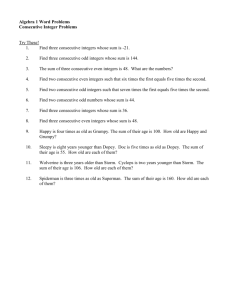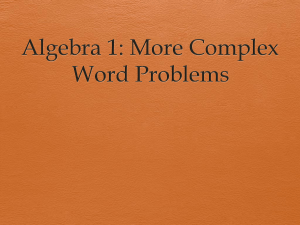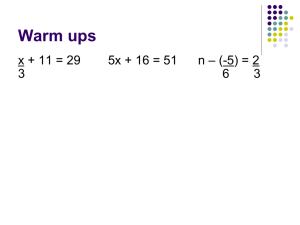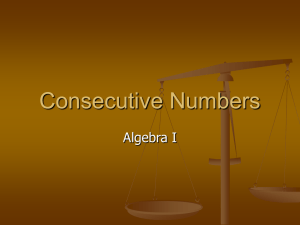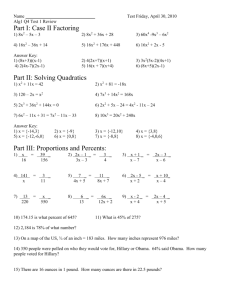ALGEBRA
advertisement
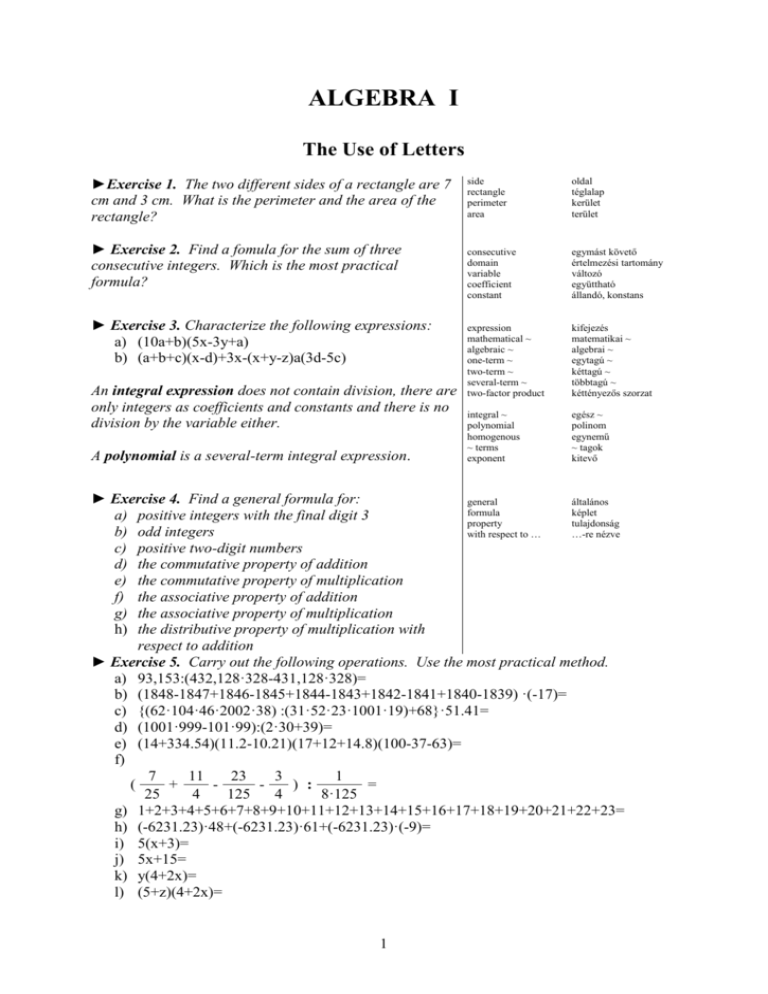
ALGEBRA I
The Use of Letters
►Exercise 1. The two different sides of a rectangle are 7
cm and 3 cm. What is the perimeter and the area of the
rectangle?
► Exercise 2. Find a fomula for the sum of three
consecutive integers. Which is the most practical
formula?
► Exercise 3. Characterize the following expressions:
a) (10a+b)(5x-3y+a)
b) (a+b+c)(x-d)+3x-(x+y-z)a(3d-5c)
An integral expression does not contain division, there are
only integers as coefficients and constants and there is no
division by the variable either.
A polynomial is a several-term integral expression.
side
rectangle
perimeter
area
oldal
téglalap
kerület
terület
consecutive
domain
variable
coefficient
constant
egymást követő
értelmezési tartomány
változó
együttható
állandó, konstans
expression
mathematical ~
algebraic ~
one-term ~
two-term ~
several-term ~
two-factor product
kifejezés
matematikai ~
algebrai ~
egytagú ~
kéttagú ~
többtagú ~
kéttényezős szorzat
integral ~
polynomial
homogenous
~ terms
exponent
egész ~
polinom
egynemű
~ tagok
kitevő
► Exercise 4. Find a general formula for:
general
általános
formula
képlet
a) positive integers with the final digit 3
property
tulajdonság
b) odd integers
with respect to …
…-re nézve
c) positive two-digit numbers
d) the commutative property of addition
e) the commutative property of multiplication
f) the associative property of addition
g) the associative property of multiplication
h) the distributive property of multiplication with
respect to addition
► Exercise 5. Carry out the following operations. Use the most practical method.
a) 93,153:(432,128·328-431,128·328)=
b) (1848-1847+1846-1845+1844-1843+1842-1841+1840-1839) ·(-17)=
c) {(62·104·46·2002·38) :(31·52·23·1001·19)+68}·51.41=
d) (1001·999-101·99):(2·30+39)=
e) (14+334.54)(11.2-10.21)(17+12+14.8)(100-37-63)=
f)
7
11
23
3
1
(
+
) :
=
25
4
125
4
8·125
g) 1+2+3+4+5+6+7+8+9+10+11+12+13+14+15+16+17+18+19+20+21+22+23=
h) (-6231.23)·48+(-6231.23)·61+(-6231.23)·(-9)=
i) 5(x+3)=
j) 5x+15=
k) y(4+2x)=
l) (5+z)(4+2x)=
1
The distributive property of multiplication with respect to
óaddition means that when multiplying a several-term
expression by a one-term expression, we get an equivalent
expression if we multiply each term of the several-term
expression by the one-term expression.
Similarly, when multiplying a several-term expression by
another several-term expression, we get an equivalent
expression if we multiply each term of the first expression
by each term of the other expression.
equivalent
equivalens
extract
extraction
factorize
factorization
group
grouping
kiemel
kiemelés
szorzattá alakít
szorzattá alakítás
csoport
csoportosítás
► Exercise 6. Prove the second rule.
► Exercise 7. Find the simplest form of:
a) (7a+13a)·9
b) (3a+5x)(4b-7y)
c) (3a+5a)(4b-7b)
d) 15ay+10xy
e) 14axy-21bxy+56cxy
f) 14ax-8ay+21bx-12by
g) 3ax-4ay+5az+6bx-8by+10bz
► Exercise 8. Find a formula for:
a) the product of two consecutive integers
b) the product of two consecutivepositive odd numbers
c) the product of two consecutivepositive integers
d) the product of two consecutivepositive even numbers
e) the sum of three consecutive positive integers
f) the sum of three consecutive positive even numbers
g) the sum of three consecutive positive odd numbers
h) the product of three consecutive integers
i) the product of three consecutive positive integers
j) the product of three consecutive positive integers where the middle one is even
k) the product of three consecutive positive integers hwere the middle one is odd
► Exercise 9. Find a formula for the product of five consecutive positive integers in terms
of the
a) smallest
b) second
c) third
d) fourth
e) largest
number.
► Exercise 10. Factorize the following several-term expressions:
a) (a-b)c-(b-a)d
e) 5x(4y-7z)+6v(7z-4y)
b) ab+ac+a
f) 28kp+14kg-10mp-5mg
c) ef-eg+fh-gh
g) ab+ac+b+c
d) (2k+4m)(l-n)-(5k-m)(n-l)
h) 12eg+13fg-12eh-13fh
2
► Exercise 11. Carry out the following operations:
a) 6.1x-5.9y+0.7z-3.1z-4.9x+2.7y
b)
2x+3
5x-6y
+
4
2
c)
d)
e)
f)
g)
h)
x+y-z-(x-y+z)-(-x+y-z)
(2x+3y)(x-5y)
(3x-y+5z)(2y+7z)
(5x-y)(4z-7)-(7t-2z)(y-5x)
(7x-3y)(2s-3t)+(2y-3x)(3t-2s)
6x+y-2
45
-
4y+1-3x
2
+
7-x+3y
4
► Exercise 12. Transform the following products into
several-term expressions. Calculate the substitution
values of the expressions before and after the
transformations, too.
a) (3a+4b) · 2x
where a=1; b=-5; x=2
b) (4x-y+2z) · 3a
where a=⅔; x=3/2; y=-3; z=-1.5
c) (3a+2x)(4b-y)
where a=1/6; b=0.2; x=1/4; y=-0.7
transform
transformation
calculate
substitution
~ value
átalakít
átalakítás
kiszámol
behelyettesítés
~-i érték
► Exercise 13. Calculate the substitution values of a²+b²
and (a+b)² for:
a) a=3, b=4
b) a=5; b=6
c) a=5; b=12
square
squared
négyzet
a négyzeten
► Exercise 14. Factorize the following several-term expressions and calculate the
substitution values before and after the transformations, too.
a) 2ax+5bx
where a=2; b=-3; x=4
b) ab+az+bx+by
where a=½; b=-1; x=⅔; y=-¼
c) 6ax-8ay+15bx-20by
where a=5; b=-2; x=-3; y=7
► Exercise 15. We know that 4·4=16. If we multiply
together two several-digit numbers ending in 4, the
product may end in 16, but not necessarily. E.g.
84·74=6216; 94·54=5076. But the last digit is always 6.
What is the condition for the ending 16( in the product of
two several-digit numbers with the final digit 4)?
3
several-digit number
end in …
may
necessarily
condition
többjegyű szám
…-re végződik
lehet, hogy
szükségképpen.
feltétlenül
feltétel
► Exercise 16. Under what conditions can we state that
a) the final two digits in the product of two positive
integers with final digits 3 and 6 respectively will
be 18?
b) the final two digits in the product of two integers
with final digits 7 and 9 respectively, will be 63?
respectively
külön-külön, a megfelelő
► Exercise 17. Calculate the following. What are the final digit of the products? Can you
see any rule?
1·2; 2·3; 3·4; 4·5; 5·6; 6·7; 7·8; 8·9, 9·10; 10·11; 11·12; 12·13; 13·14; 14·15; 15·16; 16·17;
17·18; 18·19; 19·20; etc.
► Exercise 18. After the previous exercise we may
suppose that the the series of final digits in the products
1·2; 2·3; 3·4; 4·5; 5·6; … ; n(n+1)
is a recurring series. Is this true? How can we prove it?
previous
suppose
series
prove
előző
feltesz
sorozat
bebizonyít
► Exercise 19. What is the sum of the firt 50 terms of the following infinite sum?
-4+7-4+7-4+7-4+7-4+7-4+7…
What is the sum of the firt 120 terms?
► Exercise 20. Find a formula for the first n terms of the above sum. (n can be even or
odd!)
4
►≠∞≤≥·
~
¼½¾⅓⅔⅜⅝⅞
5
